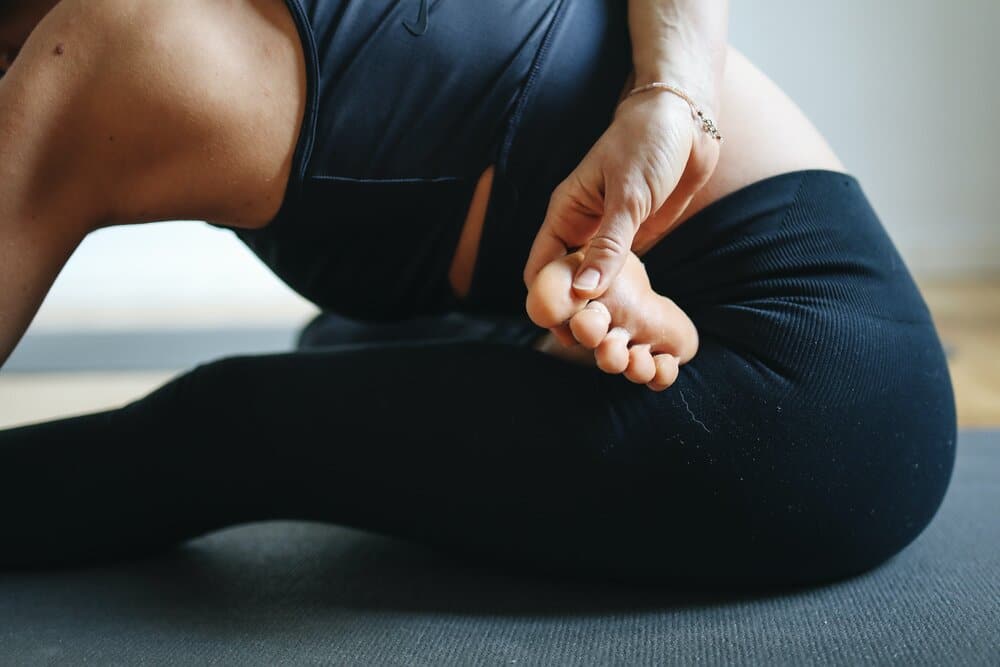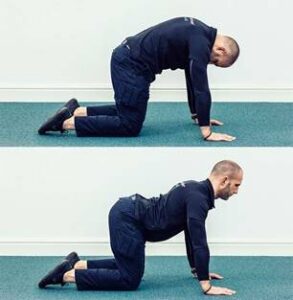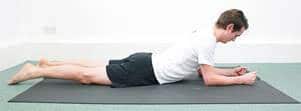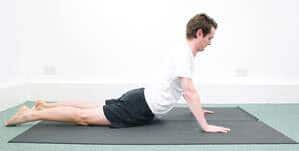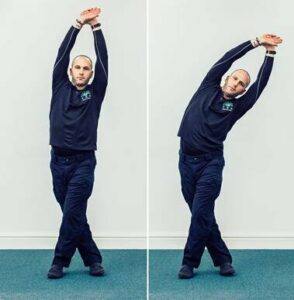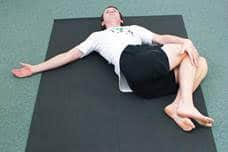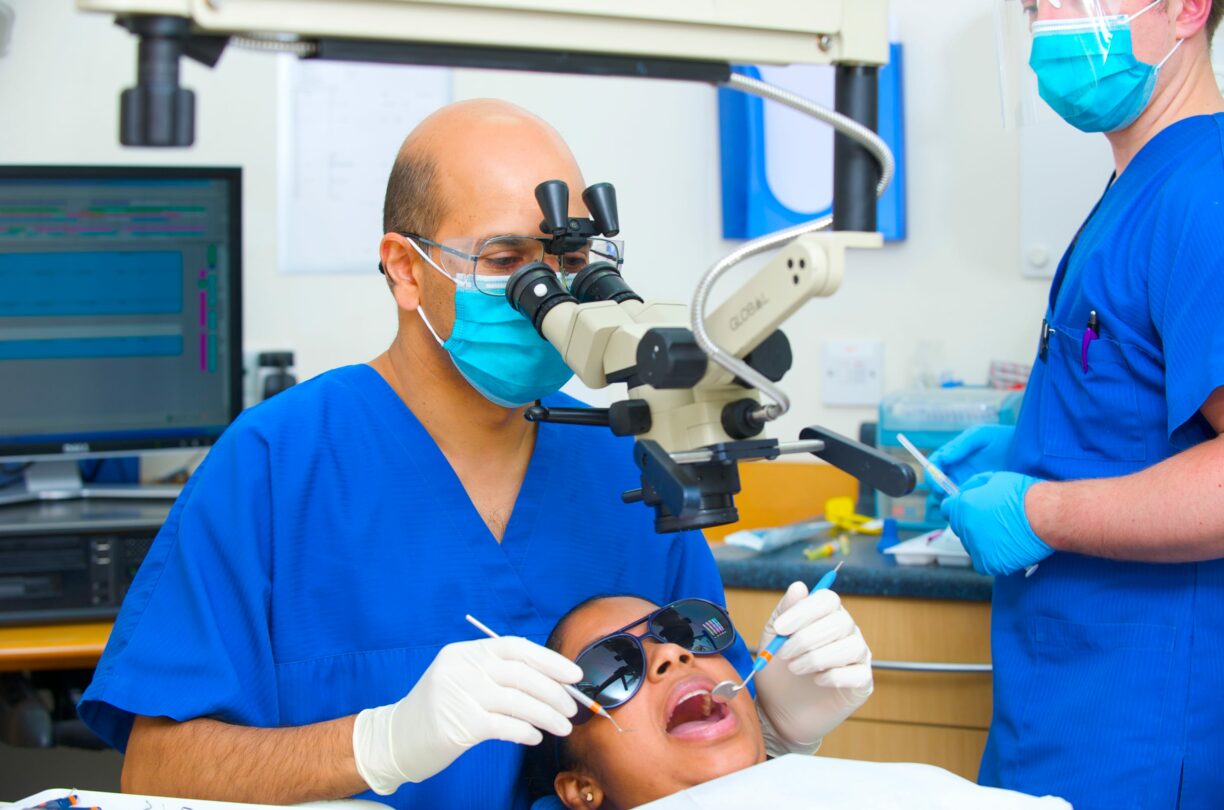By Cheyne Voss Ten Health & Fitness’s Head of Physio | UPDATED: 11:28, 20 April 2020
If, like many, you’ve found yourself struggling with back and neck pain as a result of sitting at your make-shift WFH desk – here’s my advice on how to help alleviate that during this difficult time.
WHAT YOU NEED
Start by setting aside 8-10 minutes, once (or even better, twice) a day and preferably during the evening, before bed. You’ll need a little space and, dependant on the type of floor, a mat.
The space required should be long enough for you to lie down on your back and wide enough for a full snow angel!
Your own body is all the equipment you need, and if your home environment is as hectic as mine, then it can be done in the living room, around the kids.
CAT AND COW STRETCH (FLEXION/EXTENSION)
Start with a little mobiliser. The ‘cat/cow’ stretch creates both extension and flexion (bending and lengthening). The stretch requires you to be on all fours, keeping a tidy technique by having your knees aligned with hips and wrists aligned with shoulders. While taking a big, deep breath in, arch your entire spine towards the ceiling (like an angry cat).
Whilst doing this tuck your head between your shoulders and your tailbone between your legs. We’re now going to create the polar opposite movement, by creating the ‘cow’ part of the stretch. During the following exhale, we allow the spine to gently drop towards the floor.
This creates an inverted arch to the lower spine and a little extension to the upper spine. As a result of the movement, the head lifts (a little) and the hips tip forwards towards the floor.
Due to the fluid nature to the exercise, it can be done in slow, repetitive motions. However, if you feel as though you are gaining a benefit from a particular phase of the stretch, then you can hold it for the desired length of time. It affects/stretches large parts of the spine within a simple, time-efficient movement.
PASSIVE SPINAL EXTENSION
Prone lying extension work (similar to the ‘cobra’ position in Yoga is perhaps the best way to undo a sustained period of sitting.
Lie flat on your front and relax for 1-2 mins before rising onto your elbows and holding up there for 2-3 mins then returning to lie flat.
Progress that further by pressing all the way up into full extension (using your arms not your back), hold the top for 2 seconds and return – you can repeat the full extension 10 times or so. *If this position creates pain at first go, try the ‘cricketers stretch’ below, and try again, if you keep getting pain that does not ease, you should call one of our Physio’s
SIDE STRETCH (LATERAL FLEXION/EXTENSION)
The side stretch requires 2 sets, 1 on each side. Stand with both feet on the floor. Cross the right foot in front of the left, taking as wider stance as possible. Then extend both arms towards the ceiling, gently taking the right wrist in the left hand.
Now take a nice deep breath in, drawing the right wrist to the ceiling. On the exhalation, gently pull the right wrist overhead and towards the left side. This creates a crescent or banana shape to the body (and in this case), stretching the (muscular) structures between (the right side) ribs and hips.
Taking a small number of deep breaths in (and out) will enhance the stretch. However, due to the reduced lung capacity, release the stretch and reapply the stretch when necessary.
Repeat for the opposite side – i.e. with the left foot in front of the right, and the left wrist in the right hand.
CRICKETER’S STRETCH (ROTATION)
In similar fashion to the stretch above, this requires a set on each side. This stretch focuses on the rotational element of your spine, coming mainly from the part that rotates the most: the thoracic (middle) spine.
Lie on your back, with your legs tucked together and your arms out to the side, at shoulder height. Bend your knees, so that your feet are flat on the floor and knees remaining together.
Tip your knees to the right side while keeping your left shoulder blade in contact with the floor, and slowly allowing the knees to fall towards the floor.
Due to the nature of this being a rotational-based movement, we are likely to feel the stretch develop on the left (opposite) side of the body. (You may even feel your spine ‘crack’ a little as it rotates.
This is normal.) Again, use your in and out breaths to facilitate the stretch. A quick note on this particular stretch – if you have very little movement within this stretch, don’t force it. It may take a little time to develop your full range. Again, repeat for the opposite side, with the knees falling towards the floor on the left-hand side ensuring that the right shoulder doesn’t lift.
There is always a most efficient way to deliver a stretch. However, don’t be afraid of moving your spine within its limitations. Your body’s muscles will inform you of how far you can naturally take each stretch. Whenever you can, hold the stretch for 1-3 deep breaths in and out, as the surrounding muscular structures respond to the increased lung volume.

